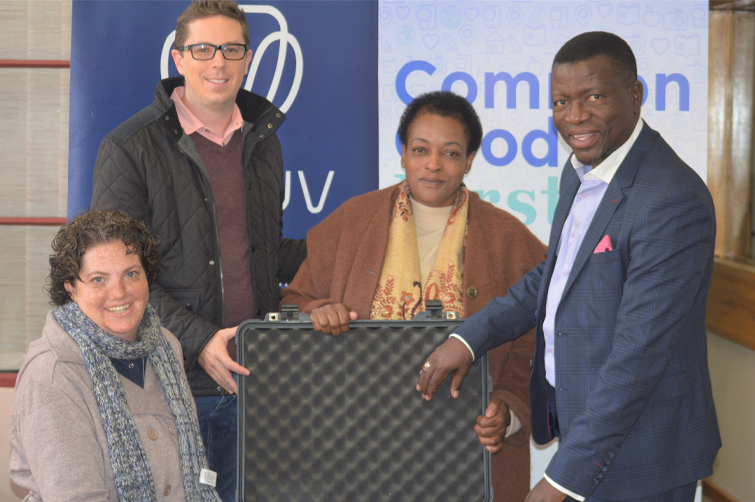Latest News Archive
Please select Category, Year, and then Month to display items
20 December 2019
|
Story Thabo Kessah
|
Photo Thabo Kessah
 Dr Deidré van Rooyen from the Centre for Development Support, Dr Jared McDonald (Department of History), Moodi Matsoso, and Bishop Billyboy Ramahlele with the mobile device.
Dr Deidré van Rooyen from the Centre for Development Support, Dr Jared McDonald (Department of History), Moodi Matsoso, and Bishop Billyboy Ramahlele with the mobile device.
In an effort to broaden the storytelling horizons and to answer to the demands of the Fourth Industrial Revolution, Community Engagement on the UFS Qwaqwa Campus recently launched the Digital Storytelling project, aimed at broadening access to good community stories.
“We have partnered with the Common Good First initiative to enhance the service that we provide as a department,” said Bishop Billyboy Ramahlele, Director: Community Engagement.
“We challenge all academics, support staff, the SRC and students in general, to take advantage of this channel to communicate their stories to the world,” he said.
Histories of royal families
“The digital documentation of the histories of the royal families in the Qwaqwa area is in the pipeline and will be conducted in partnership with the Department of History. We have come to realise that with times changing, the younger generation loses track of the precious histories, and this platform will help in preserving that,” he added.
Community Engagement coordinator, Moodi Matsoso, also revealed that space has been identified for the lab. “At the moment, we are operating on mobile digital storytelling devices, with all the necessary equipment such as tablets and cameras. However, we will soon have a fully-fledged lab on campus,” she said.
This project is co-funded by the Erasmus+ Programme of the European Union.
Apparatus to register the eye fixations of computer users
2006-01-23
Die Departement Rekenaarwetenskap en Informatika aan die Universiteit van die Vrystaat (UV) het 'n gesofistikeerde apparaat ter waarde van R230 000,00 in gebruik geneem waarmee die oogfiksasies van rekenaargebruikers geregistreer kan word. Die UV is die eerste tersiêre instelling in Afrika wat met 'n hierdie apparaat, genaamd die Eye Tracker, kan spog.
Die Eye Tracker bepaal die presiese punt op die rekenaarskerm waarna 'n gebruiker kyk en sal aangewend word om gebruikerinteraksie met rekenaarprogrammatuur te bestudeer. Terugvoer aan rekenaarprogramontwikkelaars sal verseker dat programme gebruikersvriendelik is sodat gebruikers nie noodsaaklike interaksie-elemente miskyk nie. Die Eye Tracker sal ook onder meer deur die UV se Departement Mikrobiese, Biochemiese & Voedselbiotegnologie gebruik word om te bepaal of studente na die korrekte data in grafieke kyk.

Van links: Prof. Janse Tolmie (Voorsitter: Departement Rekenaar-wetenskap en Informatika aan die UV), me Anne Jansen (van Tobii Technologies in Swede, verskaffer van die Eye Tracker) en prof. Pieter Blignaut (dosent aan die UV se Departement Departement Rekenaarwetenskap en Informatika). Foto: Lacea Loader